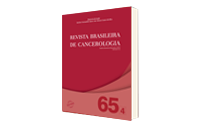Identification, Prevention and Treatment of Hand-Foot Syndrome Induced by Chemotherapy: Systematic Review
DOI:
https://doi.org/10.32635/2176-9745.RBC.2019v65n4.363Keywords:
Hand-Foot Syndrome/drug therapy, Antineoplastic Agents, Onychomycosis, Onycholysis, TaxoidsAbstract
Introduction: Hand-foot syndrome is an adverse reaction experienced by many cancer patients and a predictor of morbidity and mortality. Objective: To evaluate the scientific evidence related to the identification, prevention and treatment of chemotherapeutic-induced hand-foot syndrome, to identify the main signs and symptoms that enable the recognition of the syndrome, and to discuss the occurrence of onychomycosis in the context of the hand-foot syndrome. Method: This is a systematic review at MEDLINE/PubMed, Virtual Health Library and Scopus, including gray literature and manual search. The 29 studies included in the review were analyzed and graded according to the hierarchy of evidence levels Grading of Recommendations Assessment, Development and Evaluations (GRADE) and reliability among examiners (Kappa coefficient) was calculated. Results: It were identified studies that demonstrated efficacy in preventing hand-foot syndrome using cryotherapy and hydrotherapy. Satisfactory results were evidenced with the use of urea cream for prevention and treatment, and the use of pyridoxine showed inconclusive results. Mechanisms for identification of the syndrome and classification of inducing agents were found. The taxane group predominated among hand-foot syndrome inducing drugs. Conclusion: There are consistent evidences but do not include all drugs inducing the syndrome and do not explore other manifestations related to onycholysis and onychomycosis. The study presented results that may help prescribers to identify hand-foot syndrome, as well as alternatives for prevention and treatment. However, it is worth highlighting the need for future studies to elucidate the etiology and treatment protocols.









